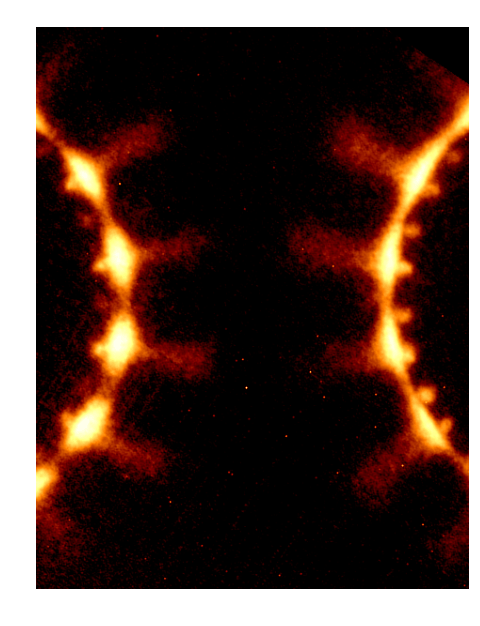Magnetic Reconnection
Magnetic reconnection is a ubiquitous and important process throughout the Universe. It explosively reconfigures the topology of magnetic field lines, and enables the rapid dissipation of magnetic energy, heating and accelerating the plasma. This process has been studied in both space and laboratory experiments, including the collisionless regime relevant to the solar wind. In recent years, high energy density experiments driven by lasers or pulsed-power have further expanded the plasmas in which we can study reconnection.

Ultra-high speed imaging of the self-emission from a magnetic reconnection experiment, showing the development of plasmoids within the reconnection layer.
In particular, recent pulsed-power experiments have demonstrated the development of the plasmoid instability, a tearing of the reconnecting current sheet, which leads to very rapid reconnection and dissipation of the magnetic energy. Although in the purely MHD regime plasmoids can only develop at high Lundquist numbers (a dimensionless measure of plasma conductivity), recent theoretical work has demonstrated the existence of a semi-collisional regime, in which two fluid effects are important, which enables plasmoids to form at much more modest conditions. As such, these pulsed-power experiments offer a qualitative window into the plasmoid instability, which is believe to be important in reconnection throughout the Universe.
We are grateful to the NSF and NNSA for supporting graduate student Thomas Varnish through award PHY2108050, “Developing Pulsed Power Driven Turbulent Reconnection Platforms”.
Related Research
- “Anomalous Heating and Plasmoid Formation in a Driven Magnetic Reconnection Experiment” by Hare et al. Our first observations of plasmoids.
- “Plasmoid instability in the semi-collisional regime” by Bhat and Loureiro. Theory and simulations in support of the semi-collisional regime.